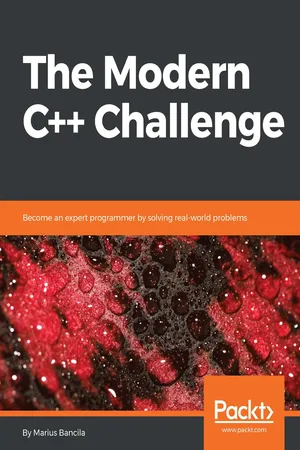
The Modern C++ Challenge
Become an expert programmer by solving real-world problems
- 328 pages
- English
- ePUB (mobile friendly)
- Available on iOS & Android
About This Book
Test your C++ programming skills by solving real-world programming problems covered in the book
Key Features
- Solve a variety of real-world programming and logic problems by leveraging the power of C++17
- Test your skills in using language features, algorithms, data structures, design patterns, and more
- Explore areas such as cryptography, communication, and image handling in C++
Book Description
C++ is one of the most widely-used programming languages and has applications in a variety of fields, such as gaming, GUI programming, and operating systems, to name a few. Through the years, C++ has evolved into (and remains) one of the top choices for software developers worldwide. This book will show you some notable C++ features and how to implement them to meet your application needs. Each problem is unique and doesn't just test your knowledge of the language; it tests your ability to think out of the box and come up with the best solutions. With varying levels of difficulty, you'll be faced with a wide variety of challenges. And in case you're stumped, you don't have to worry: we've got the best solutions to the problems in the book. So are you up for the challenge?
What you will learn
- Serialize and deserialize JSON and XML data
- Perform encryption and signing to facilitate secure communication between parties
- Embed and use SQLite databases in your applications
- Use threads and asynchronous functions to implement generic purpose parallel algorithms
- Compress and decompress files to/from a ZIP archive
- Implement data structures such as circular buffer and priority queue
- Implement general purpose algorithms as well as algorithms that solve specific problems
- Create client-server applications that communicate over TCP/IP
- Consume HTTP REST services
- Use design patterns to solve real-world problems
Who this book is for
This book will appeal to C++ developers of all levels. There's a challenge inside for everyone.
Frequently asked questions
Information
Algorithms and Data Structures
Problems
45. Priority queue
- push() to add a new element
- pop() to remove the top element
- top() to provide access to the top element
- size() to indicate the number of elements in the queue
- empty() to indicate whether the queue is empty
46. Circular buffer
- Prohibit default construction
- Support the creation of objects with a specified size
- Allow checking of the buffer capacity and status (empty(), full(), size(), capacity())
- Add a new element, an operation that could potentially overwrite the oldest element in the buffer
- Remove the oldest element from the buffer
- Support iteration through its elements
47. Double buffer
48. The most frequent element in a range
49. Text histogram
50. Filtering a list of phone numbers
51. Transforming a list of phone numbers
07555 123456 => +447555123456
07555123456 => +447555123456
+44 7555 123456 => +447555123456
44 7555 123456 => +447555123456
7555 123456 => +447555123456
52. Generating all the permutations of a string
53. Average rating of movies
54. Pairwise algorithm
55. Zip algorithm
56. Select algorithm
struct book
{
int id;
std::string title;
std::string author;
};
std::vector<book> books{
{101, "The C++ Programming Language", "Bjarne Stroustrup"},
{203, "Effective Modern C++", "Scott Meyers"},
{404, "The Modern C++ Programming Cookbook", "Marius Bancila"}};
auto titles = select(books, [](book const & b) {return b.title; });
57. Sort algorithm
Table of contents
- Title Page
- Copyright and Credits
- Packt Upsell
- Contributors
- Preface
- Math Problems
- Language Features
- Strings and Regular Expressions
- Streams and Filesystems
- Date and Time
- Algorithms and Data Structures
- Concurrency
- Design Patterns
- Data Serialization
- Archives, Images, and Databases
- Cryptography
- Networking and Services
- Bibliography
- Other Books You May Enjoy